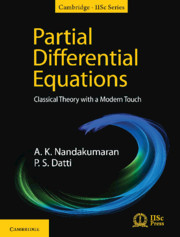Book contents
- Frontmatter
- Dedication
- Contents
- List of Illustrations
- Preface
- Acknowledgments
- Notations
- Chapter 1 Introduction
- Chapter 2 Preliminaries
- Chapter 3 First-Order Partial Differential Equations: Method of Characteristics
- Chapter 4 Hamilton–Jacobi Equation
- Chapter 5 Conservation Laws
- Chapter 6 Classification of Second-Order Equations
- Chapter 7 Laplace and Poisson Equations
- Chapter 8 Heat Equation
- Chapter 9 One-Dimensional Wave Equation
- Chapter 10 Wave Equation in Higher Dimensions
- Chapter 11 Cauchy–Kovalevsky Theorem and Its Generalization
- Chapter 12 A Peep into Weak Derivatives, Sobolev Spaces and Weak Formulation
- References
- Index
Chapter 4 - Hamilton–Jacobi Equation
Published online by Cambridge University Press: 20 May 2020
- Frontmatter
- Dedication
- Contents
- List of Illustrations
- Preface
- Acknowledgments
- Notations
- Chapter 1 Introduction
- Chapter 2 Preliminaries
- Chapter 3 First-Order Partial Differential Equations: Method of Characteristics
- Chapter 4 Hamilton–Jacobi Equation
- Chapter 5 Conservation Laws
- Chapter 6 Classification of Second-Order Equations
- Chapter 7 Laplace and Poisson Equations
- Chapter 8 Heat Equation
- Chapter 9 One-Dimensional Wave Equation
- Chapter 10 Wave Equation in Higher Dimensions
- Chapter 11 Cauchy–Kovalevsky Theorem and Its Generalization
- Chapter 12 A Peep into Weak Derivatives, Sobolev Spaces and Weak Formulation
- References
- Index
Summary
In Chapter 3, we have briefly introduced the Hamilton–Jacobi equation(HJE)
as an example of a first-order equation to derive the characteristic curves,which form the well-known system of Hamilton's ordinary differentialequations (ODE). We also have seen there an example of a minimizationproblem, where the minimum value (known as the valuefunction) need not be differentiable at some points. However,at the points where it is differentiable, the value function does satisfyHJE. Hence, it is essential to look for functions outsidethe class of smooth functions, while attempting to solve the HJE andinterpret the solution in a generalized sense. Uniqueness is also an addedissue here.
The modern theory of distributions and Sobolev spaces provides a way tointerpret the derivatives in a weak sense. The distributiontheory is essentially a linear theory though it can also beapplied to certain non-linear problems where the equation is in theconservation form like, in conservation laws, or in a variational form.There is also an attempt to extend the calculus of distributions to handlenon-linear problems using the paradifferential calculus developed by Bony;see Hörmander (1988, 1997) and the references therein. In general,fully non-linear partial differential equations (PDE) quite often cannot behandled via distribution theory. See the sample problems in examples (3.19),(3.20). Crandall, Lions and Evans (see Crandall and Lions, 1981, 1983;Crandall et al., 1984, Lions, 1982) have initiated the theory ofviscosity solutions in 1980s to study non-linear PDE ina general framework for dealing with non-smooth value functions arising inthe dynamic optimization problems, like optimal control and differentialgames. Even a brief discussion of viscosity solutions is not included herebecause of technicalities involved.
In this chapter, we consider a very particular case of HJE, where an explicitformula for the solution will be derived. This is known asHopf–Lax formula for the value function. Ofcourse, the value function need not be smooth, but it satisfies certainspecial properties. Using these special properties, we define a weakernotion of a solution. We also present a uniqueness result under this newnotion of a solution, to capture the physically relevant non-smoothsolution.
- Type
- Chapter
- Information
- Partial Differential EquationsClassical Theory with a Modern Touch, pp. 87 - 110Publisher: Cambridge University PressPrint publication year: 2020



